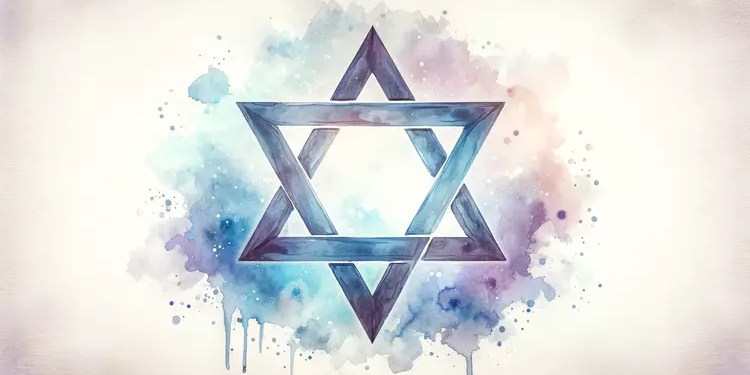The hexagram is a six-pointed star composed of two interlocking triangles.
It symbolizes the intricate balance and unity of opposing forces, serving as a key to unlocking spiritual truths and cosmic wisdom.
It encapsulates the integration of the divine with the earthly, the masculine with the feminine, and the spiritual with the material, showcasing the underlying unity that permeates the cosmos.
In this article, we explore the history and spiritual meanings of the Hexagram and offer practical ways to incorporate this symbol in your spiritual practice.
60 Sacred Symbols and Meanings
9 Sacred Geometry Healing Symbols & How to Use Them
The History of the Hexagram
Ancient Civilizations
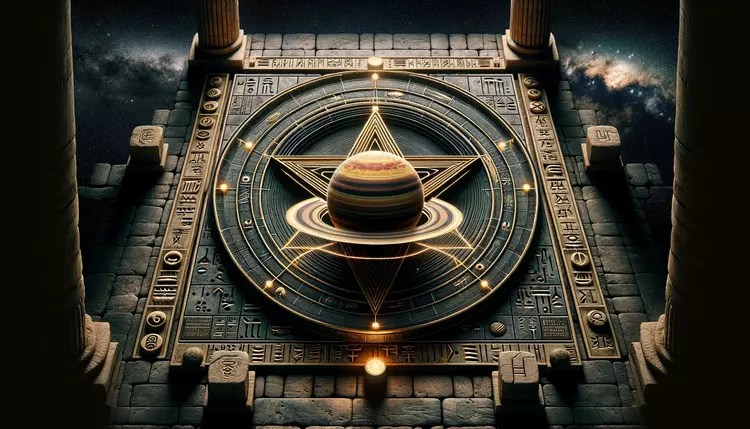
In ancient Mesopotamia, the six-pointed star was associated with celestial phenomena and was often used in astronomical and astrological contexts. For example, it was used to represent the planet Saturn in Babylonian seals and amulets.
The ancient Egyptians also incorporated the hexagram into their architecture and art, using it as a symbol of harmony and balance.
It can be found in the designs of some Egyptian temples, where it was believed to represent the perfect union of the masculine and feminine principles.
Eastern Spirituality
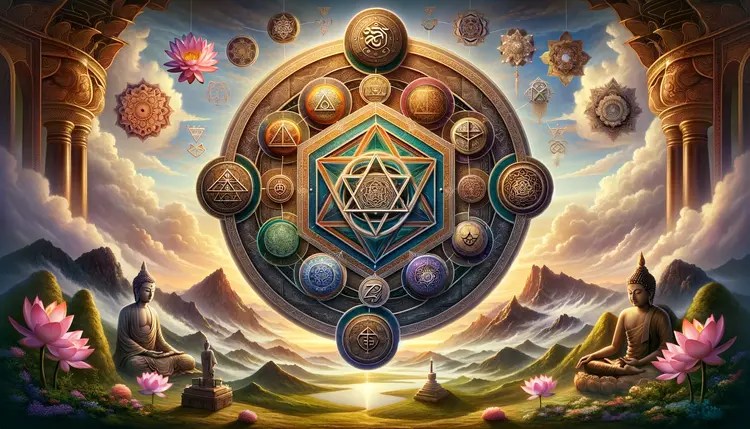
In Hinduism, the hexagram is known as the Shatkona, symbolizing the union of the divine masculine (Shiva) and the divine feminine (Shakti).
This representation is central to the philosophy of Tantra, where the interlocking triangles are seen as a depiction of the cosmic dance between these two primal forces.
In Buddhist tradition, it is often found in mandalas and thangkas, serving as a symbol of the interconnectedness of all things and the harmony between the physical and spiritual realms.
For example, the Shatkona is an integral part of the Heart chakra (Anahata) yantra. In this context it represents the harmonious balance between love and compassion, and the integration of spiritual wisdom into daily life.
7 Chakra Symbol Meanings and How to Use Them for Healing
Western Spirituality
8 Kabbalah Symbols and Meanings
In Jewish tradition, the hexagram is most commonly known as the Star of David or Magen David.
It is a symbol of Jewish identity and is believed to represent the connection between God and the Jewish people.
The two triangles are often interpreted as representing the relationship between the divine and the earthly, or the interplay between the spiritual and the material worlds.
Esoteric Traditions
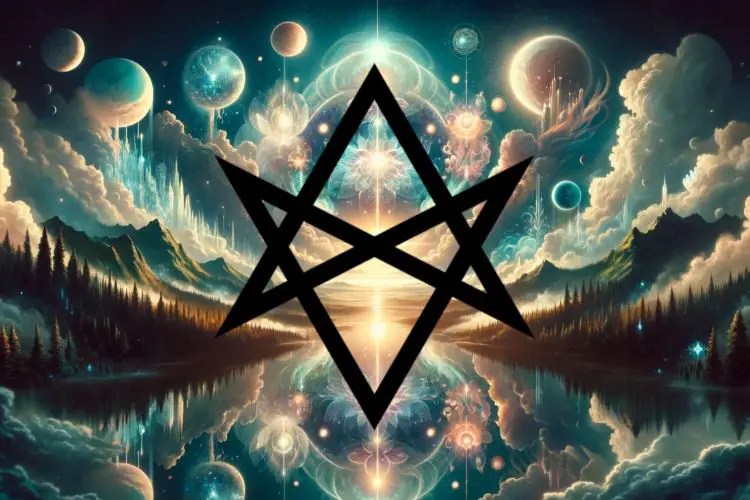
In Western esoteric traditions, the hexagram embodys the Hermetic principle of “as above, so below,” signifying the harmony between the macrocosm and microcosm, the heavens and the earth.
It is a symbol of alchemical transformation, representing the blending of opposing elements into a unified whole.
It is also used in various magical practices and rituals, symbolizing the integration of the four elements (earth, air, fire, and water) with the spirit, and serving as a protective talisman against negative energies.
A variation of the hexagram, the unicursal hexagram, has also been incorporated into esotericism. This form of the hexagram, which can be drawn in one continuous line, is associated with the Thelemic tradition, founded by Aleister Crowley.
It is often inscribed within a circle, representing the infinite and the eternal, and is used in Thelemic rituals as a symbol of the Great Work, the alchemical process of spiritual transformation and enlightenment.
Unicursal Hexagram: Origins & Meanings
The Hexagram in Sacred Geometry
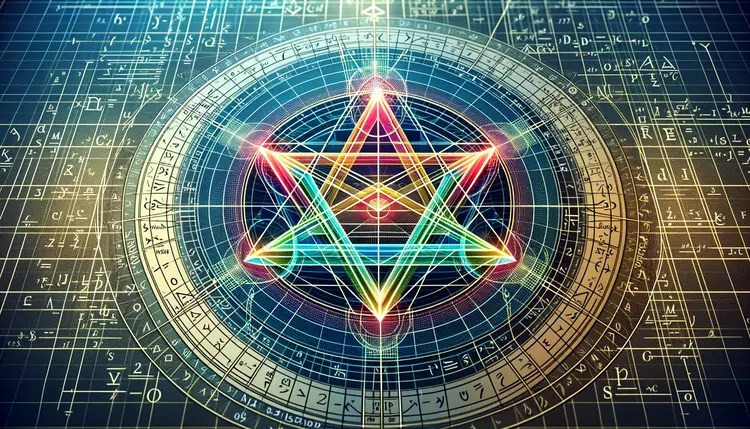
The Triangle
The triangle is the simplest polygon in geometry, and it forms the basis of the hexagram.
The hexagram is created by the union of two triangles, one pointing upward (representing the divine, the masculine, or the spiritual) and the other pointing downward (representing the earthly, the feminine, or the material).
This combination symbolizes the interplay between the heavens and the earth, the spiritual and the physical, and the balance of opposing forces.
The Flower of Life
Flower of Life: Sacred Symbol of Unity, Harmony & Creation
The Flower of Life consists of multiple evenly-spaced, overlapping circles arranged in a flower-like pattern. Within this intricate design, the hexagram, or six-pointed star, can be found as a result of the intersecting circles.
Here’s how you can find the hexagram within the Flower of Life:
- Start with the Seed of Life: The Flower of Life pattern begins with a central circle, around which six additional circles are drawn with the same diameter and with their centers located on the circumference of the central circle. This formation of seven overlapping circles is known as the Seed of Life.
- Observe the Intersection Points: In the Seed of Life, the overlapping circles create a series of intersection points. Pay attention to the points where the circles intersect to form a hexagonal shape.
- Connect the Intersection Points: To find the hexagram within the Seed of Life, connect the intersection points of the circles that form the hexagonal shape. By drawing straight lines connecting these points, you will create a six-pointed star or hexagram.
- The Hexagram in the Flower of Life: As the Flower of Life pattern expands beyond the Seed of Life with additional circles, the hexagram can be found repeatedly within the larger pattern. Each set of six circles around a central circle in the Flower of Life can be used to form a hexagram in the same way as described for the Seed of Life.
The Merkaba
Secrets of the Merkaba: Sacred Geometry and Spiritual Insights
The Merkaba is a three-dimensional shape composed of two interlocking tetrahedrons (triangular pyramids), one pointing upward and the other downward.
It is often associated with spiritual ascension and the activation of the light body.
The hexagram can be seen as a two-dimensional representation of the Merkaba, symbolizing the balance of the spiritual and physical realms and the potential for personal transformation and enlightenment.
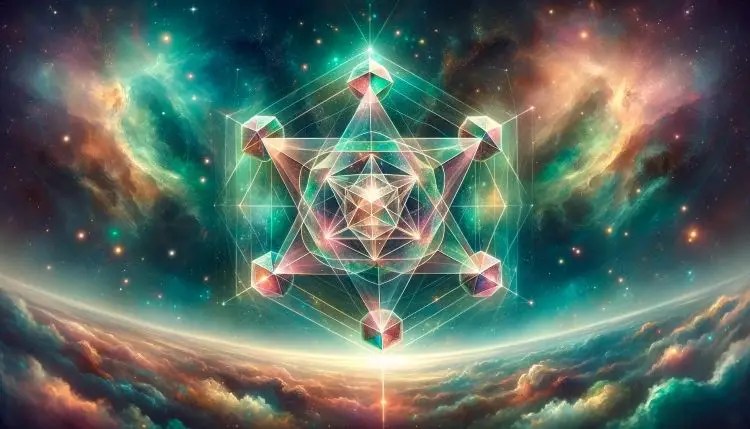
Hexagram Spiritual Meanings
Unity and Duality
The upward-pointing triangle in the hexagram represents the divine, the spiritual, or the masculine principle, while the downward-pointing triangle represents the earthly, the material, or the feminine principle.
The interlocking of these two triangles symbolizes the union of these opposing forces, creating a balance and harmony that is central to many spiritual beliefs.
This concept is reflected in the Hindu Shatkona, where the union of Shiva and Shakti represents the merging of the divine masculine and feminine energies.
Balance and Harmony
It is also a symbol of balance and harmony, as it brings together two opposing triangles in perfect equilibrium.
This balance is not just between male and female energies, but also between the physical and spiritual realms, the conscious and unconscious mind, and the inner and outer self.
The Hexagram in Alchemy
In alchemical traditions, the hexagram symbolizes the union of the four classical elements (earth, air, fire, water), with the two triangles representing the opposing elements coming together to create balance and transformation.
This alchemical interpretation highlights it’s role as a symbol of the transformative power of unity and balance.
Practical Applications of the Hexagram
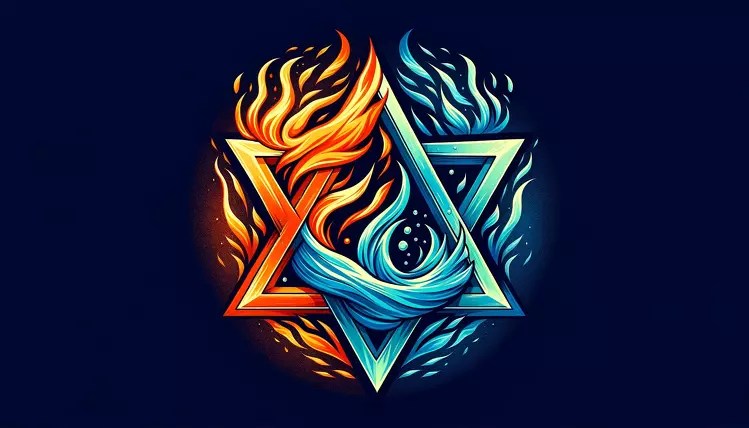
Rituals and Ceremonies
In many spiritual traditions, the hexagram plays a crucial role in creating a sacred space during rituals and ceremonies. It is often drawn on the ground or visualized in the air to invoke divine energies and establish a protective boundary.
For instance, in Wiccan ceremonies, it is used in casting circles to symbolize the balance of the elements and the union of the divine masculine and feminine.
Additionally, in ceremonial magic, it is central to the Lesser Banishing Ritual of the Hexagram.
This ritual is designed to cleanse and protect the space by banishing unwanted energies and invoking the presence of the divine. It serves to harmonize the energies within the ritual space, creating an environment conducive to spiritual work and ensuring the practitioner’s connection with higher realms.
Spiritual Protection
The hexagram is believed to offer protection against negative energies and psychic attacks.
It is often worn as a talisman or amulet, or placed in homes and spaces to create a protective shield. In some traditions, it is inscribed on doorways or windows to guard against unwanted spiritual influences.
Manifestation and Intention Setting
The balanced and harmonious nature of the hexagram makes it an ideal symbol for manifestation practices.
You can use the hexagram to visualize your goals and desires, focusing on the symbol to align your intentions with the universe’s energies.
It can also be used in spellwork or intention-setting rituals to enhance the potency of one’s desires.
Crystal Grids
The hexagram is often used as a pattern for crystal grids, which are arrangements of crystals and stones used to amplify energy and intention.
By placing crystals in a hexagram formation, practitioners believe they can harness the symbol’s harmonious energies to enhance the grid’s effectiveness in healing, protection, or manifestation.
Astrology and Tarot
In astrology, the hexagram is sometimes used to represent the harmonious aspects between planets, such as sextiles and trines, which are associated with positive energy flow and opportunities.
In tarot readings, the hexagram may be used as a symbol of guidance, helping seekers to find balance and clarity in their lives.
Final Thoughts
The spiritual meanings of the hexagram teach us about the importance of integrating opposites, embracing duality, and finding harmony within ourselves and the world around us.
By understanding and embodying the principles represented by the hexagram, we can learn to navigate life’s challenges with grace and cultivate a deeper sense of inner peace and spiritual connection.
Embrace the hexagram as a tool for meditation, allowing its geometric precision to focus your mind and elevate your consciousness. Let it be a symbol of protection, providing a sense of security as you navigate the complexities of the spiritual realm. Use it as a blueprint for manifestation, aligning your intentions with the harmonious energies of the universe.
